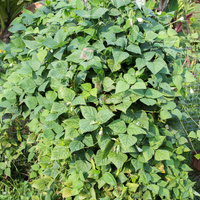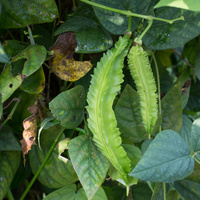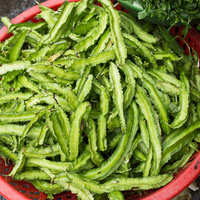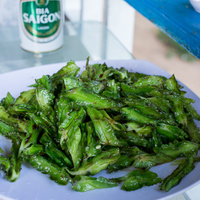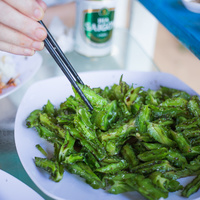Common name: Winged bean
Other common names: Asparagus bean, Dragon bean, Four-angled bean, Goa bean, Manila bean
Description
Winged Bean is a vigorous perennial vine from India and Southeast Asia that produces seedpods that are cooked and eaten as a vegetable.
Mature vines consist of rigid, herbaceous stems up to 5 m (16 ft) long and 1 cm (0.4 in) in diameter, off of which branch soft twining and climbing stems.
Leaves are trifoliate, consisting of three dark green, broadly oval and pointed leaflets. They attach to the stems through long leaf stalks and remain on the vine in all seasons.
The flowers are large and pea-like, either pale blue or, less commonly, white and borne in clusters of up to ten arising at nodes along the stems. Fertilised flowers develop into four-angled green and winged seedpods, the wings with wavy margins, sometimes with purple markings. When mature, they are 15 to 20 cm (6 to 8 in) long with small white, yellow, brown or black oval seeds inside, depending on the variety.
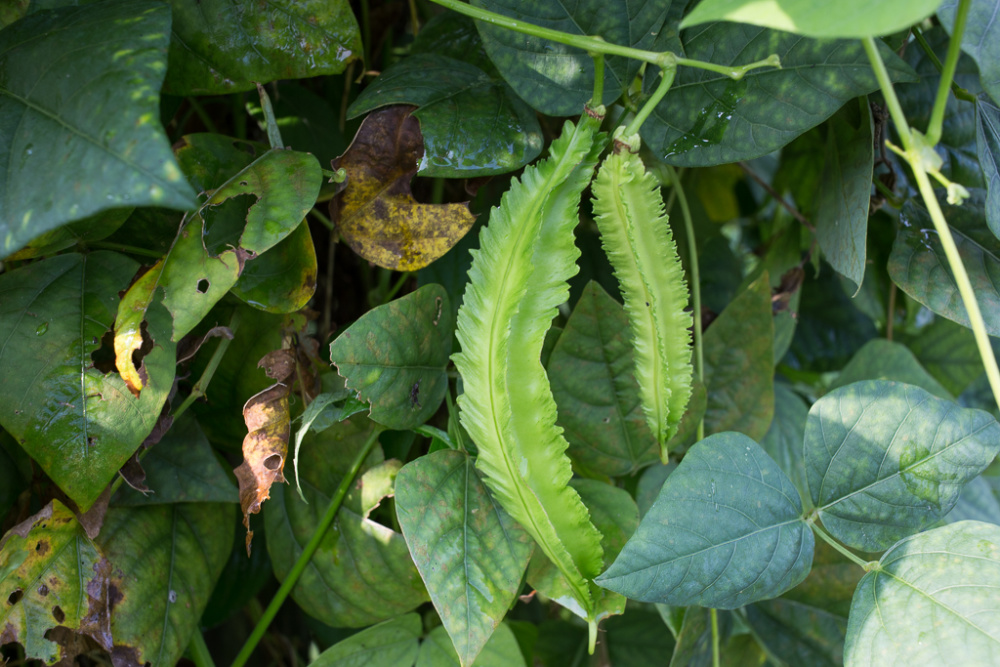
Winged beans on the vine (Singapore)
Use
The young seedpods are a good substitute for green beans and are commonly steamed or used in stir-fries. Like green beans, they become fibrous with age, so they are best harvested at about half their mature size when about 8 to 10 cm (3 to 4 in) in length.
In subtropical and tropical highland regions, the vine enters a dormant stage during the cooler months, instead developing storage tubers. These can be dug up and cooked as a starchy vegetable or peeled and added raw to salads. The tubers do not usually develop in tropical lowland climates with continually warm and wet conditions.
The seed oil is nutritionally valuable, with qualities similar to soybean oil. However, the plant's vining habit makes mechanically harvesting the seed impractical and economically unviable.
The flowers are edible, making a colourful and interesting addition to any salad. In Japan, they are dipped in tempura batter and deep-fried.
Winged Bean is not usually cultivated as green manure. Still, it is sometimes grown as a nitrogen-fixing green mulch (cover crop), including in banana plantations, to protect against soil erosion. At the same time, it enriches the soil, conserves moisture, and controls weeds.
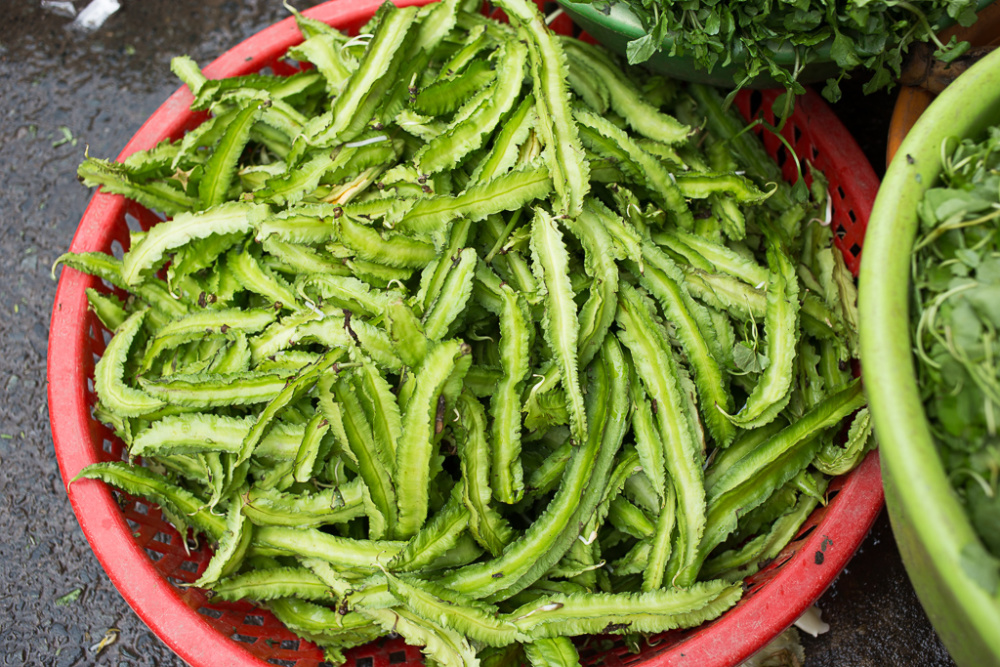
For sale (Phu Quoc Island, Vietnam)
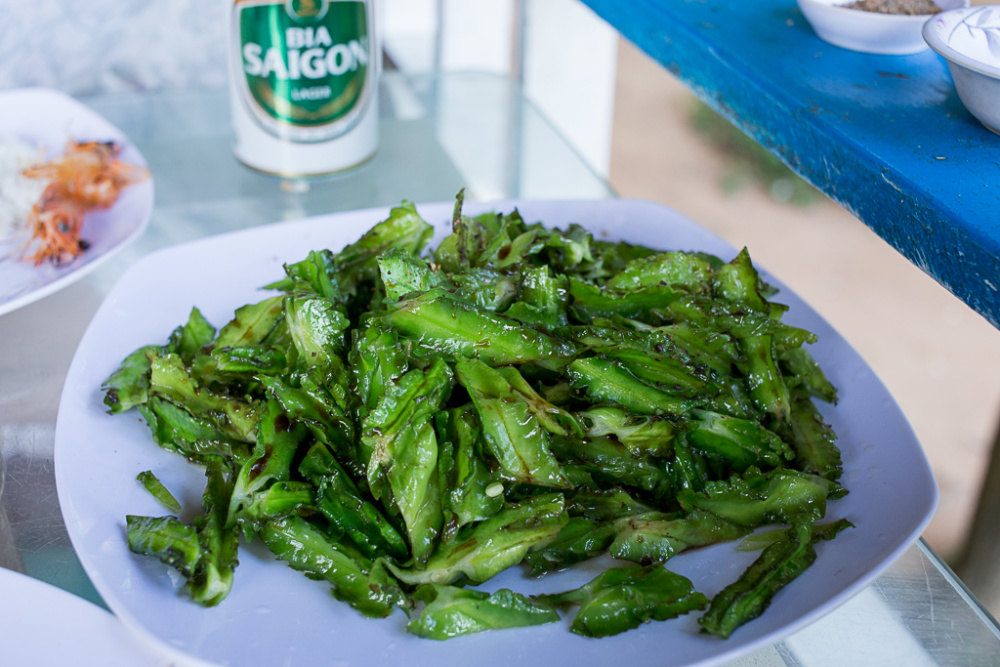
Stir-fried winged beans (Vietnam)
Climate
Grows naturally in humid subtropical and tropical climates, generally frost-free areas with annual lows of 13 to 25°C, annual highs of 24 to 35°C, annual rainfall of 900 to 4000 mm and a dry season of 6 months or less.
Winged bean vines do poorly in high-elevation climates, or where the average low of the warmest month falls below 18°C (64°F). The cool conditions resulting in low germination rates, slow growth and delayed or poor flowering.
Although the vine will die back in lowland areas with a distinct cold or dry season, it will re-sprout from the roots when warmth and moisture returns.
Winged bean vines are most productive in areas closest to the equator, where short days induce almost contentious flowering. However, the plant has been successfully introduced in subtropical areas and has flourished in South Florida (25° to 27°N), Brisbane (27° S) and Perth (32° S).
Growing
New plants usually start from seeds sown directly in the soil or first sown in containers with a free-draining potting mix, then transplanted as seedlings to the planting site. Seeds benefit from pre-treatment before sowing to encourage germination. This can be done by soaking them in just boiled water that is then left to cool.
Winged Bean plants perform best on free-draining clay-loam, loam and sandy-loam soils of a moderately acid to alkaline nature, generally with a pH of 5.0 to 8.0, and on sites with full sun exposure.
Planting is done mostly on prepared beds enriched with organic matter. The vines are staked or provided with a stout trellis to climb on, which is essential for good vine growth and pod production. Plants begin to flower in three to four months.
Around 15,000 kg of green pods can be harvested per hectare (13,000 pounds per acre) in commercial operations but as much as 35,000 kg per hectare (31,000 pounds per acre) has been reported for experimental plantings.
Problem features
Winged Bean is listed as a weed in at least one reference publication. Still, despite its widespread introduction and cultivation, there does not appear to be any record of it anywhere as a serious weed.
Where it grows
References
Books
-
Adams, C. D. 1972, Flowering plants of Jamaica, University of the West Indies, Mona, Greater Kingston
-
Allen, O. N. & Allen, E. K. 1981, The Leguminosae : a source book of characteristics, uses, and nodulation, University of Wisconsin Press, Madison, Wisconsin
-
Herklots, G. A. C. 1972, Vegetables in south-east Asia, Allen and Unwin, London
-
Litzenberger, S. C. 1974, Guide for field crops in the tropics and the subtropics, Office of Agriculture, Technical Assistance Bureau, Agency for International Development (USAID), Washington D.C.
-
Macmillan, H. F. 1943, Tropical planting and gardening : with special reference to Ceylon, 5th ed, Macmillan Publishing, London
-
National Research Council (Board on Science and Technology for International Development) 1975, Underexploited tropical plants with promising economic value, National Academic Press, Washington D. C.
-
Norrington, L. & Campbell, C. 2001, Tropical food gardens : a guide to growing fruit, herbs and vegetables in tropical and sub-tropical climates, Bloomings Books, Hawthorn, Victoria
-
Randall, R. P. 2002, A global compendium of weeds, R.G. and F.J. Richardson Press, Melbourne
-
Randall, R. P. 2007, The introduced flora of Australia and its weed status, Cooperative Research Centre for Australian Weed Management, Glen Osmond, South Australia
-
Rubatzky, V. E. & Yamaguchi, M. 1997, World vegetables : principles, production, and nutritive values, 2nd ed., Chapman & Hall, New York
-
Tindall, H. D 1983, Vegetables in the Tropics, Macmillan Press, London
